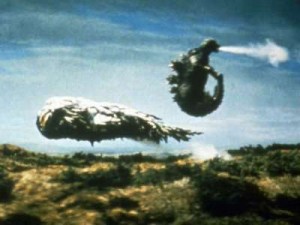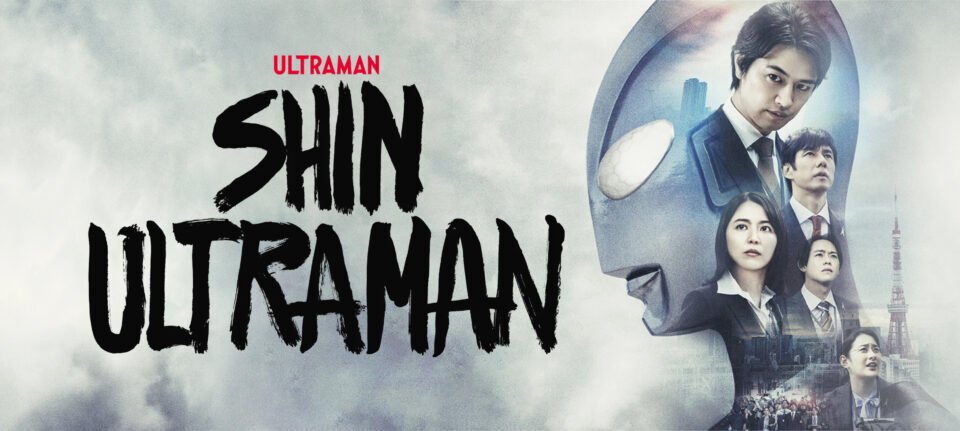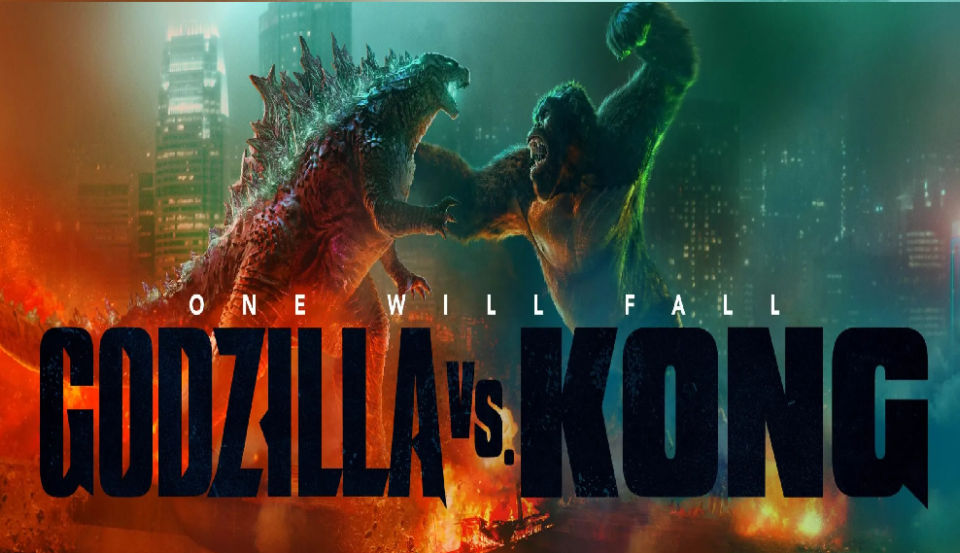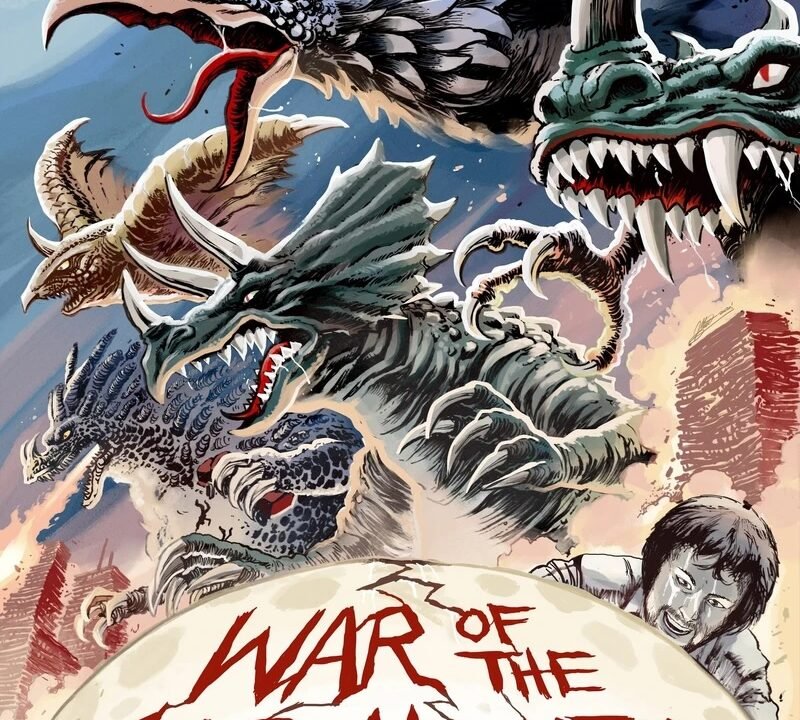
“Godzilla Vs. Gigan” Review
June 25, 2010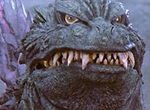
“Godzilla 2000” Review
July 2, 2010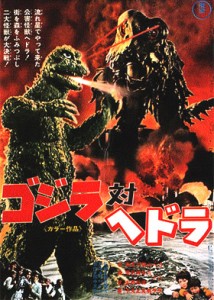 Godzilla vs. Hedorah was an enigma for me the first few times I watched it. Never had I viewed a Godzilla film with cartoon clips dispersed throughout the movie nor had I seen a Godzilla film whose film cohesiveness was so damn hard to figure out in some spots.
Godzilla vs. Hedorah was an enigma for me the first few times I watched it. Never had I viewed a Godzilla film with cartoon clips dispersed throughout the movie nor had I seen a Godzilla film whose film cohesiveness was so damn hard to figure out in some spots.
Thankfully, with repeated viewings, much of the film makes more sense. That doesn’t necessarily mean the film is done well. At the same time, though, I am not saying it’s bad; just confusing and utterly weird the first few times you watch it.
Without a doubt, I can say Godzilla vs. Hedorah is the strangest of the Godzilla films. Yet, at the same time, I must praise it for it’s message; a message that is still very relevant today.
Synopsis:
Japan’s air and water bodies are polluted with trash, smog, and other man-made muck. With so much pollution present, Hedorah is born and begins to wreak havoc at sea in its early stages of development. In an exploratory dive to figure out what Hedorah is and where it came from, Dr. Toru Yano is attacked by Hedorah, disfiguring half of his face.
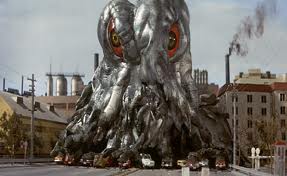 Hedorah begins to evolve and takes to the land inhaling from industrial smokestacks. But Hedorah’s initial visit to the mainland is cut short by Godzilla. The two kaiju get in a scruff until Godzilla escorts Hedorah back to sea. But during the scuffle on land, residents realize Hedorah’s muck has acidic properties that destroys any it comes in contact with. It even corrodes metal.
Hedorah begins to evolve and takes to the land inhaling from industrial smokestacks. But Hedorah’s initial visit to the mainland is cut short by Godzilla. The two kaiju get in a scruff until Godzilla escorts Hedorah back to sea. But during the scuffle on land, residents realize Hedorah’s muck has acidic properties that destroys any it comes in contact with. It even corrodes metal.
Dr. Yano discovers that Hedorah’s basic elemental property is hedrium, an element found in outer space as the by-product of exploding stars and nebula. Hedorah also has other properties, most notably sulfur which lends to the kaiju’s poisonous muck and fumes it emits when it evolves in a flying saucer-like shape. Dr. Yano realizes that the only way to destroy the Smog Monster is to dry it out with gigantic electrode panels.
Godzilla and Hedorah tussle again at an oil refinery. Hedorah, this time, bests Godzilla by getting Godzilla to choke on his sulfuric fumes as he flies off.
The military begins to construct the large electrode panels in the Japanese countryside. Hedorah shows up, but is temporarily occupied by a group of teens singing and dancing. Hedorah makes quick work of the teens, killing all except Dr. Yano’s son, Ken, and Miki Fujiyama, the girlfriend of Ken’s older brother figure, Yukio Keuchi (who died shortly after Hedorah showed up).
Godzilla shows up and the kaiju tangle for one final bout. Both exchange blows, but Hedorah begins to overtake Godzilla: burying him in sludge, burning one of his eyes, burning one of his hands, and dropping muck on him throughout the battle. Godzilla seems beaten until Hedorah shows up in between the electrodes. But an electrical issue prevents the military from setting the panels off. Thankfully, Godzilla’s heat beam sets the electrodes off. Hedorah is fried to a crisp.
Or is he?
Godzilla stomps out what remains of Hedorah’s dried body until a smaller Hedorah flies out and makes an escape attempt. But Godzilla takes to the air himself using his atomic breath. Godzilla catches up to Hedorah and flies him back to the electrodes finishing Hedorah off for good.
The story is straight-forward: Kaiju created as a result of massive amounts of pollution, kaiju wreaks havoc, Godzilla comes and saves the day. Of course, anyone familiar with the film understands that a anti-pollution message is in your face throughout. The film isn’t afraid to do so either.
The film is one of the most visually disturbing of the entire series. People are burned, disfigured, and skeletonized as a result of Hedorah. Director Yoshimitsu Banno wasn’t afraid to show the massive amounts of carnage in this film. I believe the carnage was a way of sending the anti-pollution message home to the audience.
Sprinkled throughout the movie are several cartoons depicting Hedorah. One, for example, shows him drinking oil from an oil tanker. Another shows him in his flying form consuming a factory that is producing massive amounts of smog. These clips are the strangest elements in the story. For the longest time I thought there had to be some message Banno was attempting to send in the cartoons. But the more I watched the film, the more I realized the clips are nothing more than to foreshadow some of the events to come. These clips, then, prove to be unnecessary, because it’s nothing more than redundant.
There are plot issues as well. Hedorah’s sulfuric mist, in his flying form, tends to kill everyone it comes in contact with. Yet, Ken’s mother is not harmed in one fly-over scene, but her students are affected. Even then, her students, at least from what is scene on film, don’t die themselves.
Also, how come Godzilla is able to withstand the acidic muck and sulfuric fumes so well compared to humans? How come the muck doesn’t kill a cat when it slithers through a night club in one scene? How is Godzilla’s breath able to make the electrodes function? How is Godzilla able to fly? Okay, that last question is one I’ve come to accept as is. Nevertheless, while it’s still weird, if not funny, I’ve come to enjoy it.
Perhaps the most perplexing issue of this film, which isn’t so much a plot hole, are the two orbs Godzilla pulls out of Hedorah at the end. Many fans, myself included, used to believe these were Hedorah’s eyes. But that makes no sense and no pupils are ever shown on the orbs either to verify that they are, indeed eyes. My theory, then, has been that the orbs were the hedrium that came from space and were the foundation for creating Hedorah.
The story, yes, is incoherent and head-scratching at times. If you’ve never seen the film before, you’ll be confused the first several times you watch it. But the story has some really fun moments. The story is very much focused on Hedorah and Godzilla. Banno and his writers also did a great job of making Hedorah interesting with his various metamorphosis stages and his dangerous capabilities. The audience certainly knows that Hedorah is not to be taken lightly. Even though I’ve seen the film many times, I still go into the final battle believing that Godzilla is overmatched. Such feelings are the result of excellent character setup of the villain by the writers, and Banno and his team deserve major kudos for that.
Special Effects:
The effects work for Godzilla vs. Hedorah is some of the best in the 1970s.
The numerous shots of disfigured people and dead bodies is done in a chilling manner. In one scene, a construction worker atop a metal framed building jumps (strangely) as Hedorah passes through the metal structure. The shot shows the man’s skeletal remains on the ground. Even some of his bones are shattered. The next shot shows the metal frame caving in on itself without sound. It’s a somber moment that depicts a graphic scene.
Plenty of muck is thrown around as well. The production crew had to have produced hundreds of gallons of this to use in the many shots it appears; 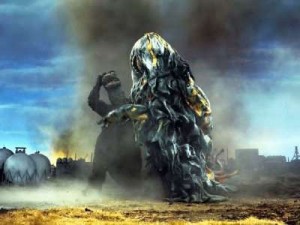 including the shot of Hedorah dumping copious amounts of it on top of Godzilla who is in a trench. I can imagine that moment must have been horrifying for Haruo Nakajima.
including the shot of Hedorah dumping copious amounts of it on top of Godzilla who is in a trench. I can imagine that moment must have been horrifying for Haruo Nakajima.
Unfortunately, with budgets being slashed drastically at this point, not as many miniatures show up in this movie. What does show up is done well. Hedorah’s initial landfall has a nice set of miniatures. My favorite effects scene of the movie is the oil refinery scene. While, like Hedorah’s initial landfall, there aren’t a lot of miniatures here, what is present does give the impression of a large refinery with massive explosions surrounding Hedorah and Godzilla as they battle one another.
The base of Mt. Fuji, used as the location for the final battle, is beautiful. While most fans are unimpressed with rural locations, most don’t realize the vast number of hours put in by the film crew to build these large rural landscapes. With Godzilla vs. Hedorah, we even get trenches and hills built into the landscape, giving the final battle a bit of a variety in the terrain.
The film has a handful of screen composition shots that are blended in really well. One of the most notable scenes is Hedorah flying over Toshie Yano and her class. The blended shots are seamless and work really well.
Hedorah’s suit is beautiful. The sludge effect of the suit is very believable even if muck is never actually dripping from him. Godzilla’s suit is holding up well also. This is the third time this suit was used in a Godzilla film, a money-saving move for Toho. The suit would be used one last time in the following film, Godzilla vs. Gigan. The suit, in that film, appears to be coming apart in some shots. A result of the number of times the suit had been used and, I’m sure, due to the brutal punishment it took in this movie where muck was poured on it and burned.
The effects work is really top-notch despite the film having a smaller budget than many of its predecessors. Teruyoshi Nakano did a wonderful job.
Acting:
There aren’t a whole lot of characters in the movie. We have a group of four characters with Dr. Yano and Ken dominating much of the screen time. Both characters play the most important roles while the others are there to further make a point.
The acting is done fairly well, though. Akira Yamauchi, as Dr. Yano, is the strongest of the actors in the film. He carries a look of concern throughout much of the movie, understanding that Hedorah is a serious threat to humanity.
Hiroyuki Kawase, who plays Ken Yano, is the typical child character. He loves Godzilla and imitates him in a couple of scenes. Kawase gives Ken a personality of fearlessness, which many child actors of the time were instructed to do with their characters. While his acting is good, I find his fearlessness to not be authentic for a child his age being put into such situations that his character is put through in the film. He doesn’t run away from Hedorah when he shows up.
However, his most powerful moment comes shortly after Hedorah and Godzilla tangle in the oil refinery. As Ken is running around, frantically searching for his mother, he comes across numerous dead bodies. At one point, he covers his eyes, wimpers and runs in the opposite direction.
While most Godzilla films of the 1970s, tend to be a little light on the kaiju action, Godzilla vs. Hedorah gives us plenty of the kaiju as well as three battles between Godzilla and Hedorah.
The battles are well choreographed and the tide of battle changes in a realistic way when either kaiju executes a particular move. These battles help to illustrate how powerful Hedorah truly is and how uncertain we should be of Godzilla coming out this movie alive.
The first two battles are fairly short, but the final battle is an epic heavyweight bout. The kaiju go back and forth, trading blows until Hedorah begins to gain the upper hand throughout much of the latter half of the battle.
Like with most Godzilla movies, the highlight are the battles. This film gives the audience plenty of battles and general kaiju action.
Overall:
Godzilla vs. Hedorah tends to stand out in the franchise due to how bizarre it is at some points. The cartoon clips, strange film edits in several spots, and 70s-style film transitions certainly aid in the weird aspects of the film. It certainly was enough to make me confused in my first several viewings of the film.
The anti-pollution message is very heavy-handed, but serves the movie very well. The theme certainly had not been done before prior to this movie.
The numerous shots of dead and disfigured bodies is horrifying and disturbing even for today’s standards. But the carnage helps in building the theme Banno is wanting to build.
The effects are great and there is plenty of kaiju action; more than most other Godzilla films would have during the same decade. And the Godzilla flying scene? Well, it’s truly bizarre. But I’ve warmed up to it in recent years and find that it brings some charm to the film. The kid inside definitely enjoys that fantastical moment.
The film, as a whole, does have a charm to it that I’ve only begun to notice in more recent viewings. The film definitely has quite a few problems; some of which I wished were addressed. But its entertainment value is very high regardless of many of those negative points.
I would recommend giving Godzilla vs. Hedorah several viewings. It’s a film that isn’t for every Godzilla fan, but I can definitely see why many older fans, who grew up watching this on local T.V. stations, find this film so enjoyable.


